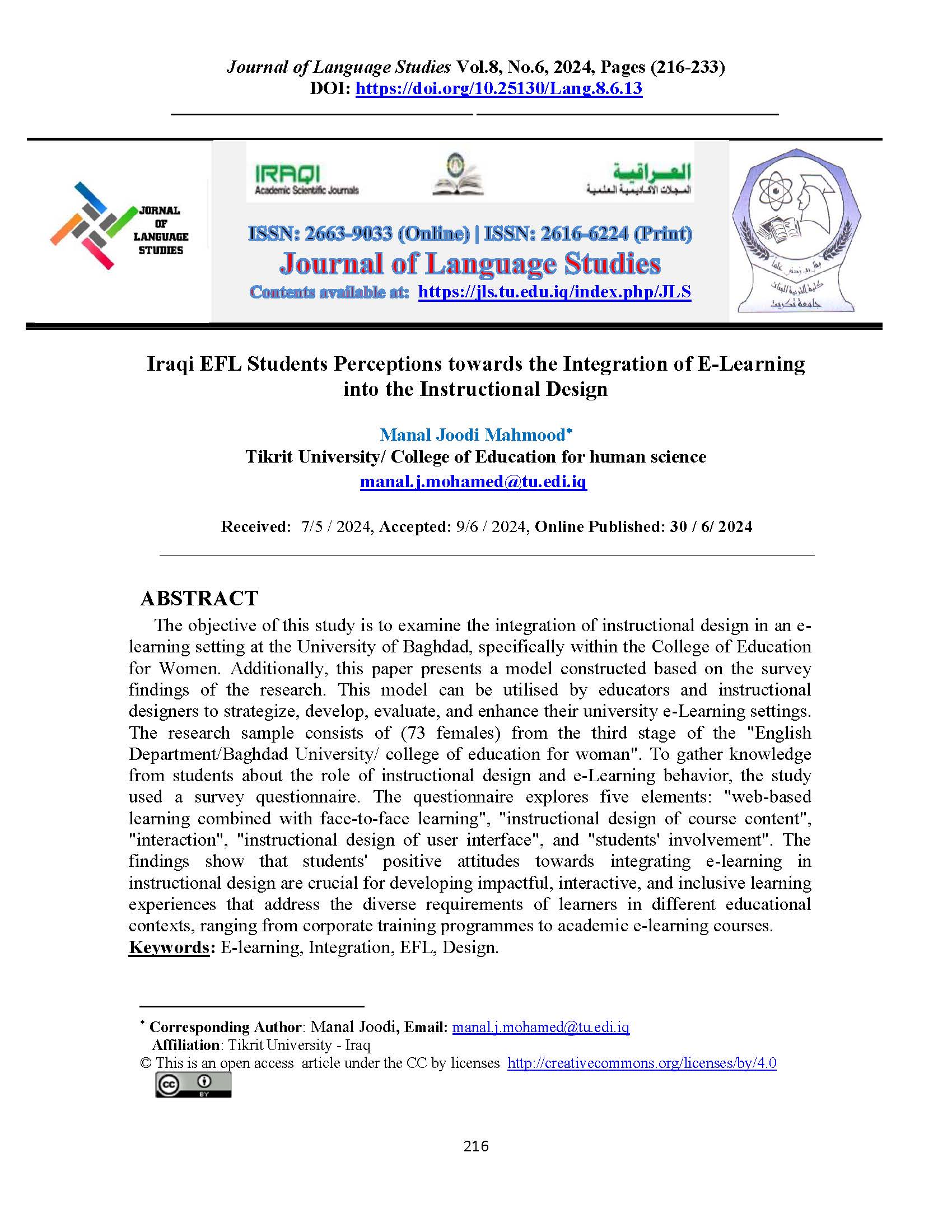Iraqi EFL Students Perceptions towards the Integration of E-Learning into the Instructional Design
DOI:
https://doi.org/10.25130/Lang.8.6.13Keywords:
E-learning, Integration, EFL, DesignAbstract
The objective of this study is to examine the integration of instructional design in an e-learning setting at the University of Baghdad, specifically within the College of Education for Women. Additionally, this paper presents a model constructed based on the survey findings of the research. This model can be utilised by educators and instructional designers to strategize, develop, evaluate, and enhance their university e-Learning settings. The research sample consists of (73 females) from the third stage of the "English Department/Baghdad University/ college of education for woman". To gather knowledge from students about the role of instructional design and e-Learning behavior, the study used a survey questionnaire. The questionnaire explores five elements: "web-based learning combined with face-to-face learning", "instructional design of course content", "interaction", "instructional design of user interface", and "students' involvement". The findings show that students' positive attitudes towards integrating e-learning in instructional design are crucial for developing impactful, interactive, and inclusive learning experiences that address the diverse requirements of learners in different educational contexts, ranging from corporate training programmes to academic e-learning courses.
References
Abbad, M. M., Morris, D., & de Nahlik, C. (2009). Looking under the Bonnet: Factors Affecting Student Adoption of E-Learning Systems in Jordan. The International Review of Research in Open and Distance Learning.
AL-ahbaby, T. D. A., & Al Azzawi, I. T. (2024). The influence of strategic competence on Iraqi EFL university students' conversations. journal of Language Studies, 8(1), 355-375.
Best, John W. & Kahn, James V. (2006). Research in Education. USA. Pearson Education Inc. 3rd ed.
Brown, A. (1997), “Designing for learning: what are the essential features of an effective online course?”, Australian Journal of Educational Technology, Vol. 13 No. 2, pp. 115-29.
Bull, K. S., Kimball, S. L., & Stansberry, S. (1998). Instructional Design in Computer-Mediated Learning. Paper presented at the Coming Together: Preparing for Rural Special Education in the 21st Century. Conference Proceedings of the American Council on Rural Special Education (18th, Charleston, SC, March 25-28, 1998), U.S., Oklahoma.
Bynom, A. (2001). Going the Information Given, New York: Norton Press.
Chou, C. (2003), “Interactivity and interactive function in web-based learning systems: a teaching framework for designers”, British Journal of Educational Technology, Vol. 34 No. 3, pp. 265-79.
Dick, W., Carey, L., & Carey, J. O. (2005). The Systematic Design of Instruction (6th ed.). Boston: Pearson, Allyn, and Bacon.
Dublin, L. (2003). If you only look under the street lamps or nine e-Learning Myths. The e-Learning developers journal. http://www.eLearningguild.com.
European Commission (2001). The eLearning Action Plan: Designing tomorrow’s education. http://www.elearningeuropa.info.
Fry, K. (2001). E-learning markets and providers: some issues and prospects, Education Training, 233-239.
Graff, M. (2003), “Learning from web-based instructional systems and cognitive style”, British Journal of Educational Technology, Vol. 34 No. 4, pp. 407-18.
Greening, T. (1998). WWW support of student learning: A case study. Australian Journal of Educational Technology, 14(1), 49-59.
Greening, T. (1998). WWW support of student learning: A case study. Australian Journal of Educational Technology, 14(1), 49-59.
Jolliffe, A., Ritter, J. and Steven, D. (2001), The Online Learning Handbook, No. 4, Routledge, London, pp. 249-77.
Moore, G.S., Winograd, K. and Lange, D. (2001), You Can Teach Online: Building a Creative Learning Environment, McGraw-Hill, New York, NY.
Oblinger, D. G., & Hawkins, B. L. (2005). The myth about E-learning. Educause review.
Oliver, R., Herrington, J. and Omari, A. (1997), “Creating effective instructional materials for the world wide web”, available at: http://cleo.murdoch.edu.au/ajet/ajet15/oliver.html.
Ragan, L.C. (1999), “Good teaching is good teaching: an emerging set of guiding principles for the design and development of distance education”, Cause/Effect, Vol. 22 No. 1, available at: www.educause.edu/ir/library/html/cem9915.html.
Richard, H., & Haya, A. (2009). Examining student decision to adopt web 2.0 technologies: theory and empirical tests, Journal of computing in higher education, 21(3), 183-198.
Ritchie, D. and Hoffman, B. (1996), Using the WWW for Instruction, not Just Information, Association for the Advancement of Computing in Education (AACE) SITTE ’96, Phoenix/Mesa, AZ.
Rossi.P.G. (2009). A learning environment with artificial intelligence elements. Journal of e-learning and knowledge society, 5(1), 67-75.
Scott, N., & Judd, K. (2002). Efficient continuous online assessment of large classes: Continuous diagnostic assessment in engineering & mathematics subjects. Retrieved 3rd August 2004, from http://www.cshe.unimelb.edu.au/assessinglearning/04/case13.html
Siragusa, L. (2000), “Instructional design meets online learning in higher education”, Australian Journals of Educational Technology, Vol. 27 No. 13, pp. 95-104.
Siragusa, L., & Dixon, K. C. (2005b). A theoretical framework for research and development intobsound online learning in higher education. Peer-reviewed paper presented at the AARE 2005bInternational Education Research Conference. Creative Dissent: Constructive Solutions, New SouthbWales: Parramatta.
Smith, P. L., & Ragan, T. J. (2005). Instructional Design (3rd ed.). NJ: John Wiley & Sons, Inc.
Verma, G. K. and R. M. Beard (1981). What is educational research?:perspectives on techniques of research, United Kingdom: Gower Publishing Company.
Wang, Y. S., Wang, Y. M., Lin, H. H., & Tang, T. I. (2007). Determinants of user acceptance of Internet banking: An empirical study. International Journal of Service Industry Management, 14, 501–519.
Weller, M. (2002). Delivering Learning on the Net: The why what & how of online education, London: Kegan Page.

